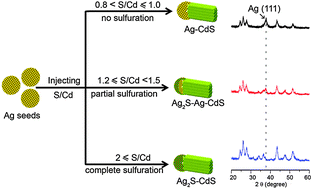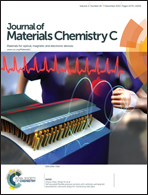Generalized seeded growth of Ag-based metal chalcogenide nanorods via controlled chalcogenization of the seeds†
Abstract
Hybrid metal–semiconductor nanostructures are promising candidates for photocatalytic applications because of the efficient charge separation in the nanostructure. Silver nanocrystals can be used as seeds to synthesize hybrid nanostructures, providing great optical and electronic properties. But they are not much explored because they tend to get oxidized or sulfurized. Here, we report a general protocol for synthesizing Ag based hybrid metal chalcogenide nanorods using the complex of oleylamine and chalcogenide as a precursor. This method allows for the epitaxial growth of metal chalcogenides without sulfurization of Ag seeds by controlled release of chalcogenides in the reaction process. From the experimental analysis, we propose a growth mechanism of the heteronanorod formation. That is, the metal sulfide firstly grows on one side of the Ag seeds, while the other side of the Ag seed is sulfurized and the Ag2S phase is formed subsequently in the presence of an excess sulfur precursor. The synthetic method is demonstrated to be widely applicable for organic phase metal chalcogenide nanorod growth, including CdS, ZnS, MnS, and CdSe. Moreover, the hybrid nanorods without sulfurization of the Ag seeds exhibit significantly improved photocatalytic activity, due to the efficient charge separation in these materials.


 Please wait while we load your content...
Please wait while we load your content...